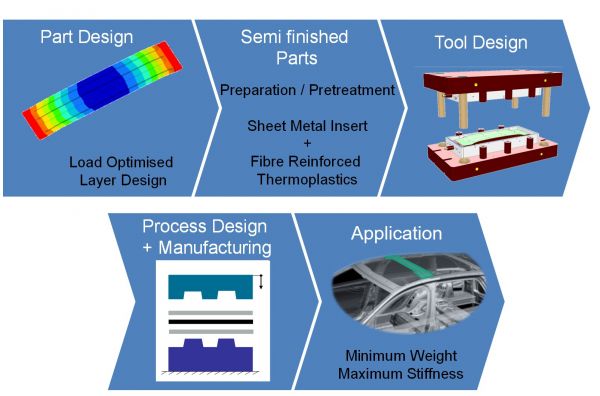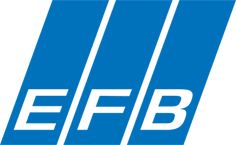InverTec - Load Optimized Inverse Composite Technology

InverTec Process chain for composite manufacturing
Because of their high specific stiffness and strength fibre reinforced plastics (FRP) are preferred lightweight materials. Recent developments show a growing industrial interest in the integration of thermoplastic FRP in complex structures for high volumes. However, there are still shortcomings for these materials concerning the insufficient energy absorption in case of failure and the limited opportunities available for the assembly with other components. Improvements in the crash performance can be achieved for instance with the selective reinforcement of the FRP structure with ductile metallic inserts.
Based on this approach the goal of the current project is to develop a novel load optimized hybrid composite consisting of a continuous fibre reinforced thermoplastic matrix, in which a metal insert will be integrated. Besides the improvement of crash performance the metallic insert is to be additionally used for the effective connection of the composite to the adjacent metallic structures. For the efficient manufacturing of the novel composite in high-volume applications, conventional sheet metal forming methods shall be used. The project consortium consists of the following partners and corresponding fields of expertise:
TU Chemnitz: Manufacturing Technologies for FRPs, Load Path Aligned Design of Lightweight Structures
Fraunhofer IWU: Sheet Metal Forming Technologies, Design of Forming Tools, Process Design
Wroclaw University of Science and Technology: Surface-Engineering, Material Research, Production Engineering, Product and Process Development, Simulation and Optimisation
To improve the bonding between the metallic insert and the organic sheet, an innovative combination of form fit and material fit is sought. Thereby the form fit is realised by the integration of interlocking elements in the metal insert and the adhesive bond is realized by a coating on the metallic insert. The inverse hybrid composite manufactured in this way is to be optimized in terms of large plastic deformations and high strain rates. Compared to conventional sandwich composites made with metallic outer layers and a fibre reinforced plastic core the benefits are:
weight reduction of more than 25 % at same stiffness in comparison to monolithic metal
high damage tolerance in the event of a crash (ductile behaviour of the metallic insert attenuate the abrupt failure of the FRP)
excellent joinability with adjacent metallic structures
highly integrated component structures in the sense of an intelligent lightweight construction with an excellent cost-benefit ratio and the load-oriented use of FRP
outstanding performance in dynamics and durability
combining the advantages of metal sheets and the variety of available technologies with the advantages of organic sheets
With the gained knowledge the lightweight potential of hybrid composites can be used for a broader range of applications at SMEs. Through the use of assemblies made of load-oriented hybrid composites, economic savings potentials can be achieved by saving drive energy of accelerated assemblies. The targeted systematic studies on the forming behaviour and the component properties of the new developed innovative composite open up new and sustainable solutions at SMEs for an intelligent lightweight construction and their implementation in large-scale production.
Therewith the current trend to reduce CO2-emissions, for instance in automotive industry and its suppliers (SMEs), is taken into account. The novel inverse composite technology enables completely new possibilities for cost-effective design through more complex single components, functional integration and shortened process chains. In addition to the automotive industry, these effects can be realised particularly in mechanical engineering.
This means that an impetus to different economic sectors, especially for small and medium-sized enterprises, which are working in the fields of FRP manufacturing, sheet metal forming, vehicle manufacturing, aerospace and appliances, can be expected.
Results

